belt MERCEDES-BENZ CLK430 CABRIOLET 2003 C208 Owner's Guide
[x] Cancel search | Manufacturer: MERCEDES-BENZ, Model Year: 2003, Model line: CLK430 CABRIOLET, Model: MERCEDES-BENZ CLK430 CABRIOLET 2003 C208Pages: 341, PDF Size: 10.33 MB
Page 68 of 341
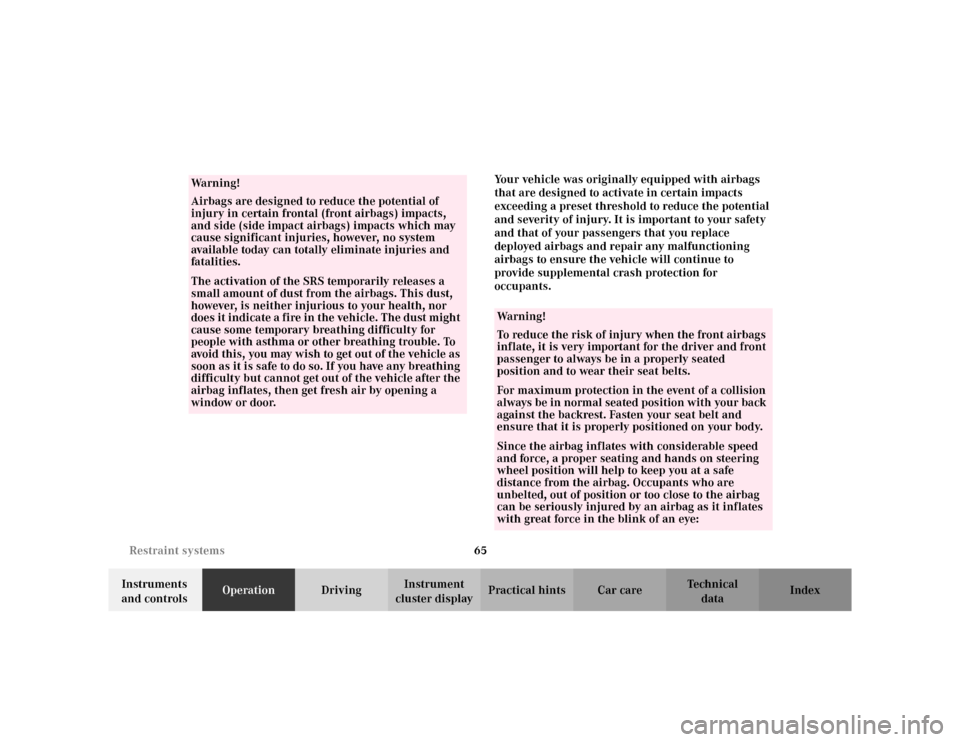
65 Restraint systems
Te ch n i c a l
data Instruments
and controlsOperationDrivingInstrument
cluster displayPractical hints Car care IndexYour vehicle was originally equipped with airbags
that are designed to activate in certain impacts
exceeding a preset threshold to reduce the potential
and severity of injury. It is important to your safety
and that of your passengers that you replace
deployed airbags and repair any malfunctioning
airbags to ensure the vehicle will continue to
provide supplemental crash protection for
occupants.
Wa r n i n g !
Airbags are designed to reduce the potential of
injury in certain frontal (front airbags) impacts,
and side (side impact airbags) impacts which may
cause significant injuries, however, no system
available today can totally eliminate injuries and
fatalities.The activation of the SRS temporarily releases a
small amount of dust from the airbags. This dust,
however, is neither injurious to your health, nor
does it indicate a fire in the vehicle. The dust might
cause some temporary breathing difficulty for
people with asthma or other breathing trouble. To
avoid this, you may wish to get out of the vehicle as
soon as it is safe to do so. If you have any breathing
difficulty but cannot get out of the vehicle after the
airbag inflates, then get fresh air by opening a
window or door.
Wa r n i n g !
To reduce the risk of injury when the front airbags
inflate, it is very important for the driver and front
passenger to always be in a properly seated
position and to wear their seat belts.For maximum protection in the event of a collision
always be in normal seated position with your back
against the backrest. Fasten your seat belt and
ensure that it is properly positioned on your body.Since the airbag inflates with considerable speed
and force, a proper seating and hands on steering
wheel position will help to keep you at a safe
distance from the airbag. Occupants who are
unbelted, out of position or too close to the airbag
can be seriously injured by an airbag as it inflates
with great force in the blink of an eye:
Page 69 of 341
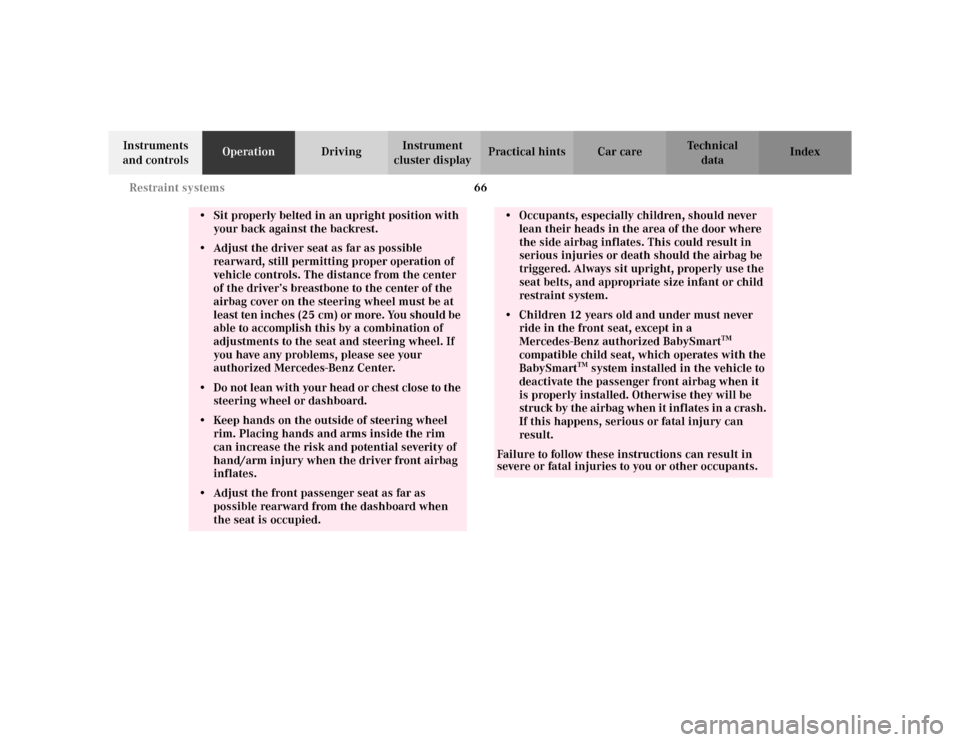
66 Restraint systems
Te ch n i c a l
data Instruments
and controlsOperationDrivingInstrument
cluster displayPractical hints Car care Index
• Sit properly belted in an upright position with
your back against the backrest.• Adjust the driver seat as far as possible
rearward, still permitting proper operation of
vehicle controls. The distance from the center
of the driver’s breastbone to the center of the
airbag cover on the steering wheel must be at
least ten inches (25 cm) or more. You should be
able to accomplish this by a combination of
adjustments to the seat and steering wheel. If
you have any problems, please see your
authorized Mercedes-Benz Center.• Do not lean with your head or chest close to the
steering wheel or dashboard.• Keep hands on the outside of steering wheel
rim. Placing hands and arms inside the rim
can increase the risk and potential severity of
hand/arm injury when the driver front airbag
inflates.• Adjust the front passenger seat as far as
possible rearward from the dashboard when
the seat is occupied.
• Occupants, especially children, should never
lean their heads in the area of the door where
the side airbag inflates. This could result in
serious injuries or death should the airbag be
triggered. Always sit upright, properly use the
seat belts, and appropriate size infant or child
restraint system.• Children 12 years old and under must never
ride in the front seat, except in a
Mercedes-Benz authorized BabySmart
TM
compatible child seat, which operates with the
BabySmart
TM system installed in the vehicle to
deactivate the passenger front airbag when it
is properly installed. Otherwise they will be
struck by the airbag when it inflates in a crash.
If this happens, serious or fatal injury can
result.
Failure to follow these instructions can result in
severe or fatal injuries to you or other occupants.
Page 70 of 341
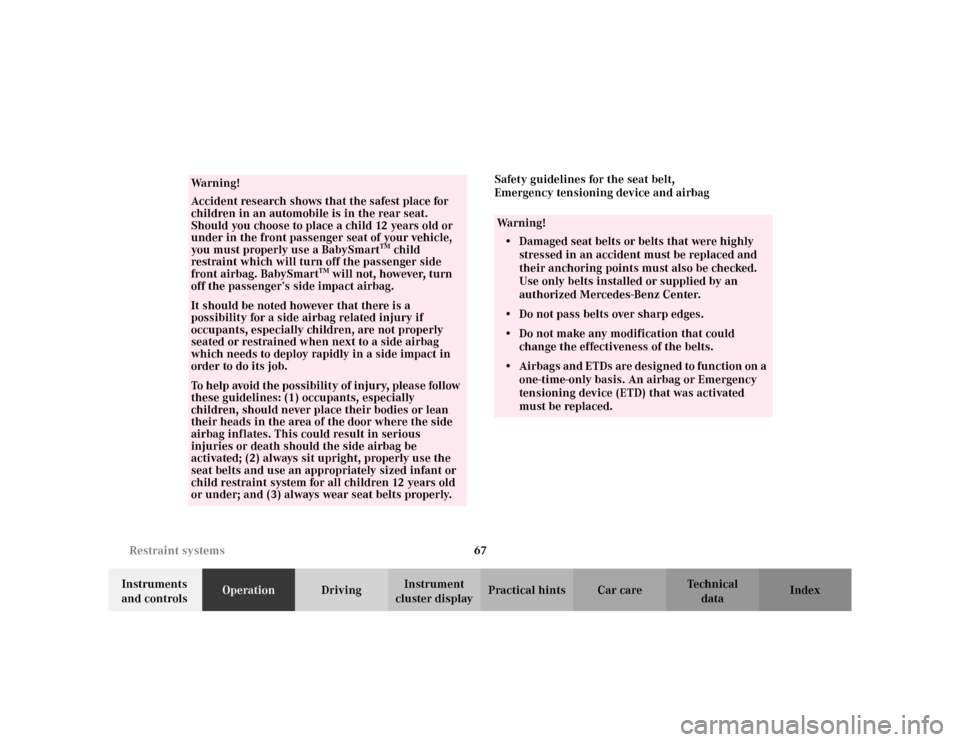
67 Restraint systems
Te ch n i c a l
data Instruments
and controlsOperationDrivingInstrument
cluster displayPractical hints Car care IndexSafety guidelines for the seat belt,
Emergency tensioning device and airbag
Wa r n i n g !
Accident research shows that the safest place for
children in an automobile is in the rear seat.
Should you choose to place a child 12 years old or
under in the front passenger seat of your vehicle,
you must properly use a BabySmart
TM child
restraint which will turn off the passenger side
front airbag. BabySmart
TM will not, however, turn
off the passenger’s side impact airbag.
It should be noted however that there is a
possibility for a side airbag related injury if
occupants, especially children, are not properly
seated or restrained when next to a side airbag
which needs to deploy rapidly in a side impact in
order to do its job.To help avoid the possibility of injury, please follow
these guidelines: (1) occupants, especially
children, should never place their bodies or lean
their heads in the area of the door where the side
airbag inflates. This could result in serious
injuries or death should the side airbag be
activated; (2) always sit upright, properly use the
seat belts and use an appropriately sized infant or
child restraint system for all children 12 years old
or under; and (3) always wear seat belts properly.
Wa r n i n g !
• Damaged seat belts or belts that were highly
stressed in an accident must be replaced and
their anchoring points must also be checked.
Use only belts installed or supplied by an
authorized Mercedes-Benz Center.• Do not pass belts over sharp edges.• Do not make any modification that could
change the effectiveness of the belts.• Ai rba gs an d E T Ds are d esi gned to fun c tion on a
one-time-only basis. An airbag or Emergency
tensioning device (ETD) that was activated
must be replaced.
Page 72 of 341
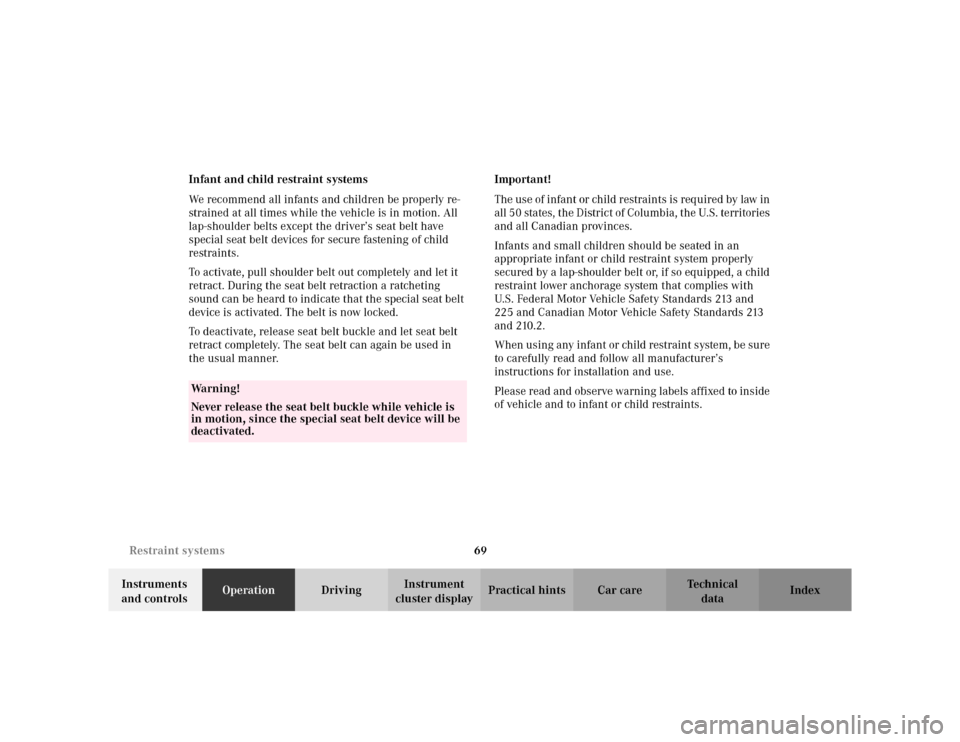
69 Restraint systems
Te ch n i c a l
data Instruments
and controlsOperationDrivingInstrument
cluster displayPractical hints Car care Index Infant and child restraint systems
We recommend all infants and children be properly re-
strained at all times while the vehicle is in motion. All
lap-shoulder belts except the driver’s seat belt have
special seat belt devices for secure fastening of child
restraints.
To activate, pull shoulder belt out completely and let it
retract. During the seat belt retraction a ratcheting
sound can be heard to indicate that the special seat belt
device is activated. The belt is now locked.
To deactivate, release seat belt buckle and let seat belt
retract completely. The seat belt can again be used in
the usual manner.Important!
The use of infant or child restraints is required by law in
all 50 states, the District of Columbia, the U.S. territories
and all Canadian provinces.
Infants and small children should be seated in an
appropriate infant or child restraint system properly
secured by a lap-shoulder belt or, if so equipped, a child
restraint lower anchorage system that complies with
U.S. Federal Motor Vehicle Safety Standards 213 and
225 and Canadian Motor Vehicle Safety Standards 213
and 210.2.
When using any infant or child restraint system, be sure
to carefully read and follow all manufacturer’s
instructions for installation and use.
Please read and observe warning labels affixed to inside
of vehicle and to infant or child restraints.
Wa r n i n g !
Never release the seat belt buckle while vehicle is
in motion, since the special seat belt device will be
deactivated.
Page 73 of 341
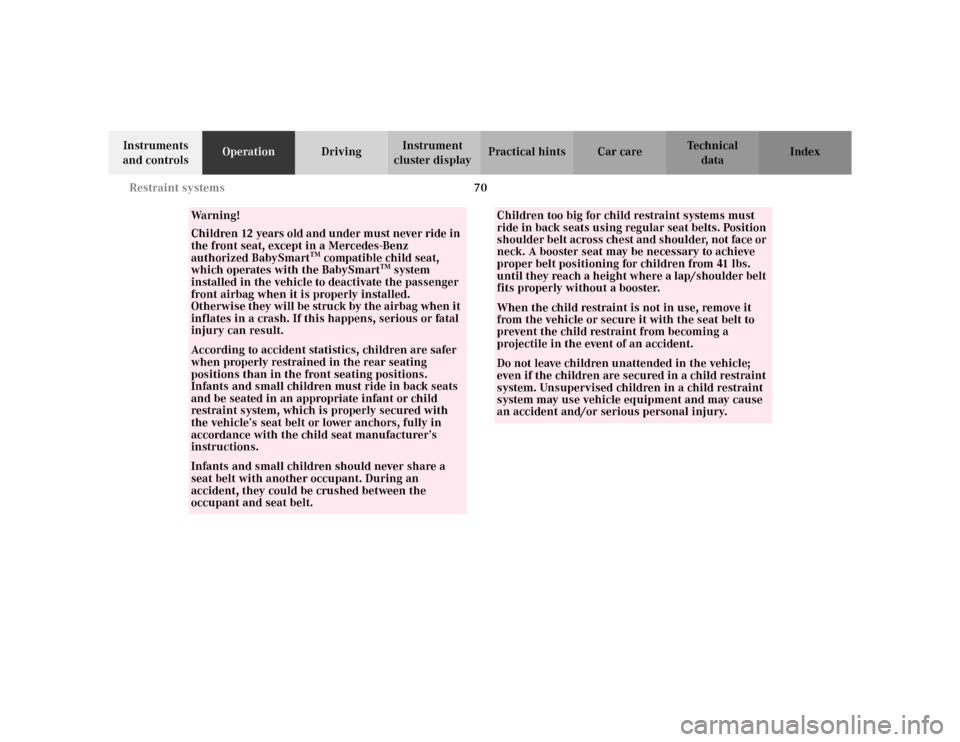
70 Restraint systems
Te ch n i c a l
data Instruments
and controlsOperationDrivingInstrument
cluster displayPractical hints Car care Index
Wa r n i n g !
Children 12 years old and under must never ride in
the front seat, except in a Mercedes-Benz
authorized BabySmart
TM compatible child seat,
which operates with the BabySmart
TM system
installed in the vehicle to deactivate the passenger
front airbag when it is properly installed.
Otherwise they will be struck by the airbag when it
inflates in a crash. If this happens, serious or fatal
injury can result.
According to accident statistics, children are safer
when properly restrained in the rear seating
positions than in the front seating positions.
Infants and small children must ride in back seats
and be seated in an appropriate infant or child
restraint system, which is properly secured with
the vehicle’s seat belt or lower anchors, fully in
accordance with the child seat manufacturer’s
instructions.Infants and small children should never share a
seat belt with another occupant. During an
accident, they could be crushed between the
occupant and seat belt.
Children too big for child restraint systems must
ride in back seats using regular seat belts. Position
shoulder belt across chest and shoulder, not face or
neck. A booster seat may be necessary to achieve
proper belt positioning for children from 41 lbs.
until they reach a height where a lap/shoulder belt
fits properly without a booster.When the child restraint is not in use, remove it
from the vehicle or secure it with the seat belt to
prevent the child restraint from becoming a
projectile in the event of an accident.Do not leave children unattended in the vehicle;
even if the children are secured in a child restraint
system. Unsupervised children in a child restraint
system may use vehicle equipment and may cause
an accident and/or serious personal injury.
Page 74 of 341
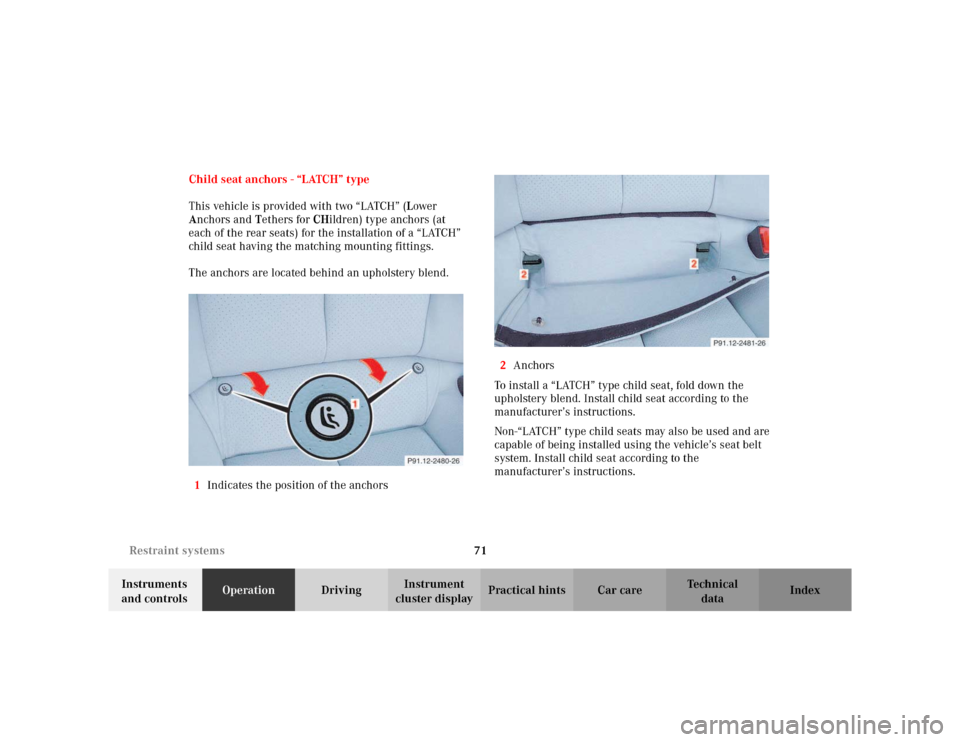
71 Restraint systems
Te ch n i c a l
data Instruments
and controlsOperationDrivingInstrument
cluster displayPractical hints Car care Index Child seat anchors - “LATCH” type
This vehicle is provided with two “LATCH” (Lower
Anchors and Tethers for CHildren) type anchors (at
each of the rear seats) for the installation of a “LATCH”
child seat having the matching mounting fittings.
The anchors are located behind an upholstery blend.
1Indicates the position of the anchors2Anchors
To install a “LATCH” type child seat, fold down the
upholstery blend. Install child seat according to the
manufacturer’s instructions.
Non-“LATCH” type child seats may also be used and are
capable of being installed using the vehicle’s seat belt
system. Install child seat according to the
manufacturer’s instructions.
Page 75 of 341
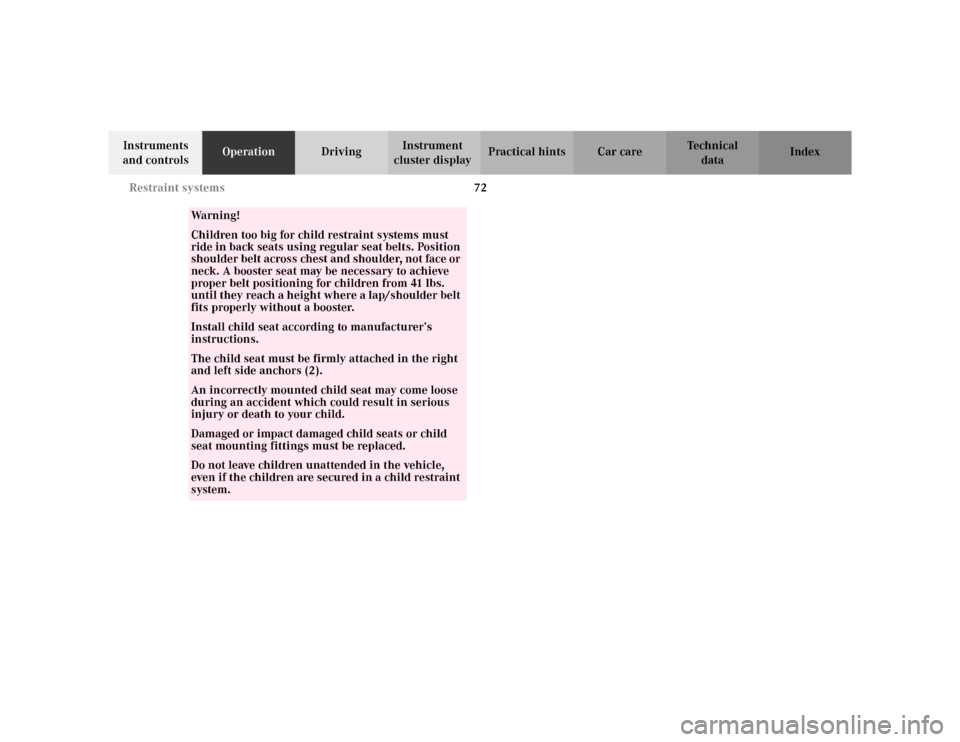
72 Restraint systems
Te ch n i c a l
data Instruments
and controlsOperationDrivingInstrument
cluster displayPractical hints Car care Index
Wa r n i n g !Children too big for child restraint systems must
ride in back seats using regular seat belts. Position
shoulder belt across chest and shoulder, not face or
neck. A booster seat may be necessary to achieve
proper belt positioning for children from 41 lbs.
until they reach a height where a lap/shoulder belt
fits properly without a booster.Install child seat according to manufacturer’s
instructions.The child seat must be firmly attached in the right
and left side anchors (2).An incorrectly mounted child seat may come loose
during an accident which could result in serious
injury or death to your child.Damaged or impact damaged child seats or child
seat mounting fittings must be replaced.Do not leave children unattended in the vehicle,
even if the children are secured in a child restraint
system.
Page 83 of 341
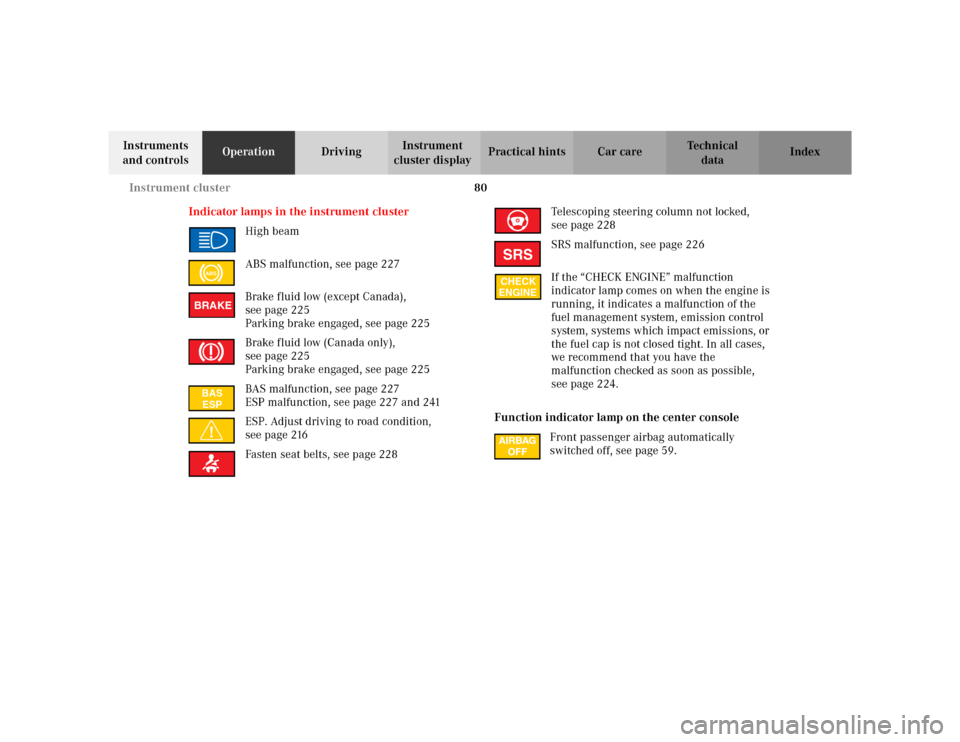
80 Instrument cluster
Te ch n i c a l
data Instruments
and controlsOperationDrivingInstrument
cluster displayPractical hints Car care Index
Indicator lamps in the instrument cluster
High beam
ABS malfunction, see page 227
Brake fluid low (except Canada),
seepage225
Parking brake engaged, see page 225
Brake fluid low (Canada only),
seepage225
Parking brake engaged, see page 225
BAS malfunction, see page 227
ESP malfunction, see page 227 and 241
ESP. Adjust driving to road condition,
seepage216
Fasten seat belts, see page 228Telescoping steering column not locked,
seepage228
SRS malfunction, see page 226
If the “CHECK ENGINE” malfunction
indicator lamp comes on when the engine is
running, it indicates a malfunction of the
fuel management system, emission control
system, systems which impact emissions, or
the fuel cap is not closed tight. In all cases,
we recommend that you have the
malfunction checked as soon as possible,
seepage224.
Function indicator lamp on the center console
Front passenger airbag automatically
switched off, see page 59.
ABSBRAKEBAS
ESP
SRSCHECK
ENGINE
Page 173 of 341
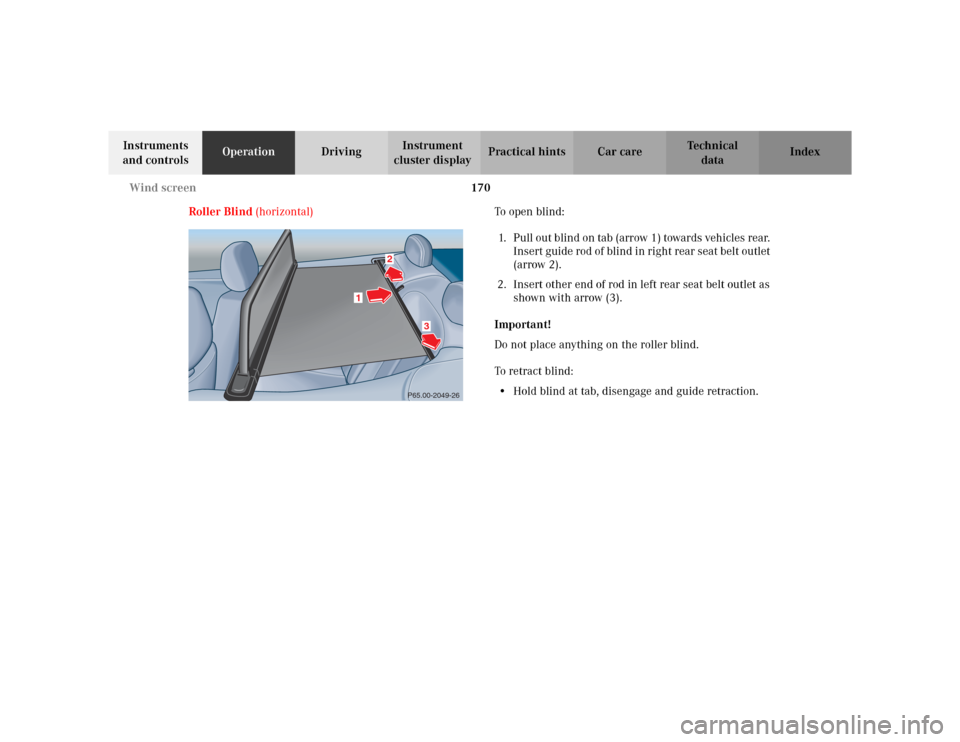
170 Wind screen
Te ch n i c a l
data Instruments
and controlsOperationDrivingInstrument
cluster displayPractical hints Car care Index
Roller Blind (horizontal) To o p e n b l i n d :
1. Pull out blind on tab (arrow 1) towards vehicles rear.
Insert guide rod of blind in right rear seat belt outlet
(arrow 2).
2. Insert other end of rod in left rear seat belt outlet as
shown with arrow (3).
Important!
Do not place anything on the roller blind.
To retract blind:
•Hold blind at tab, disengage and guide retraction.
3
1
2
P65.00-2049-26
Page 226 of 341
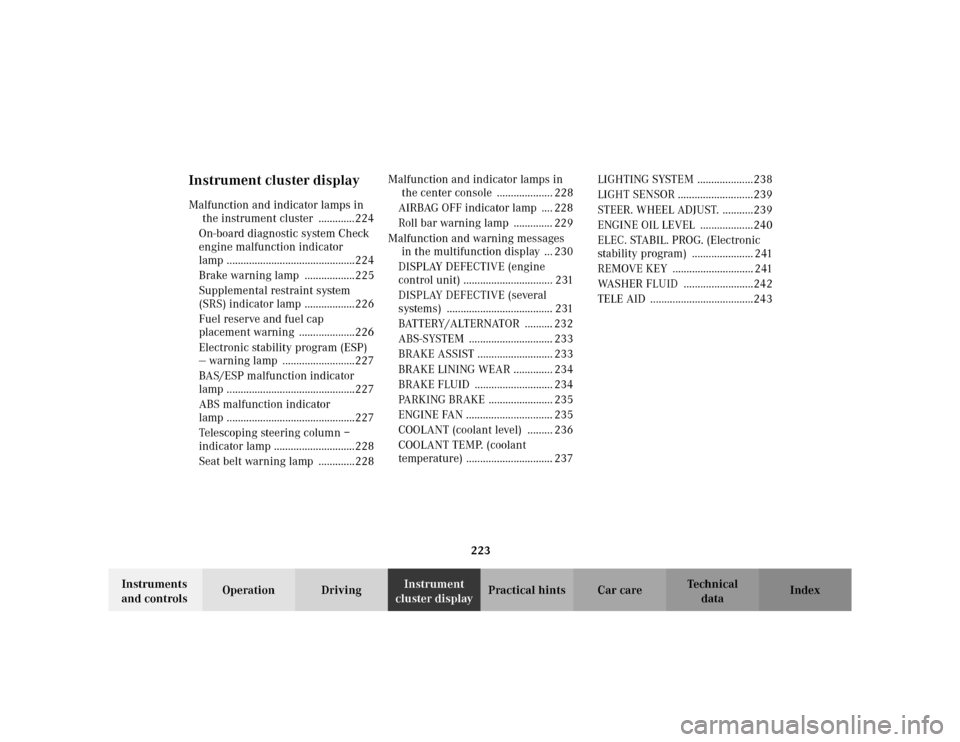
223
Te ch n i c a l
data Instruments
and controlsOperation DrivingInstrument
cluster displayPractical hints Car care Index
Instrument cluster displayMalfunction and indicator lamps in
the instrument cluster .............224
On-board diagnostic system Check
engine malfunction indicator
lamp ..............................................224
Brake warning lamp ..................225
Supplemental restraint system
(SRS) indicator lamp ..................226
Fuel reserve and fuel cap
placement warning ....................226
Electronic stability program (ESP)
— warning lamp ..........................227
BAS/ESP malfunction indicator
lamp ..............................................227
ABS malfunction indicator
lamp ..............................................227
Telescoping steering column –
indicator lamp .............................228
Seat belt warning lamp .............228Malfunction and indicator lamps in
the center console .................... 228
AIRBAG OFF indicator lamp .... 228
Roll bar warning lamp .............. 229
Malfunction and warning messages
in the multifunction display ... 230
DISPLAY DEFECTIVE (engine
control unit) ................................ 231
DISPLAY DEFECTIVE (several
systems) ...................................... 231
BATTERY/ALTERNATOR .......... 232
ABS-SYSTEM .............................. 233
BRAKE ASSIST ........................... 233
BRAKE LINING WEAR .............. 234
BRAKE FLUID ............................ 234
PARKING BRAKE ....................... 235
ENGINE FAN ............................... 235
COOLANT (coolant level) ......... 236
COOLANT TEMP. (coolant
temperature) ............................... 237LIGHTING SYSTEM ....................238
LIGHT SENSOR ...........................239
STEER. WHEEL ADJUST. ...........239
ENGINE OIL LEVEL ...................240
ELEC. STABIL. PROG. (Electronic
stability program) ...................... 241
REMOVE KEY ............................. 241
WASHER FLUID .........................242
TELE AID .....................................243